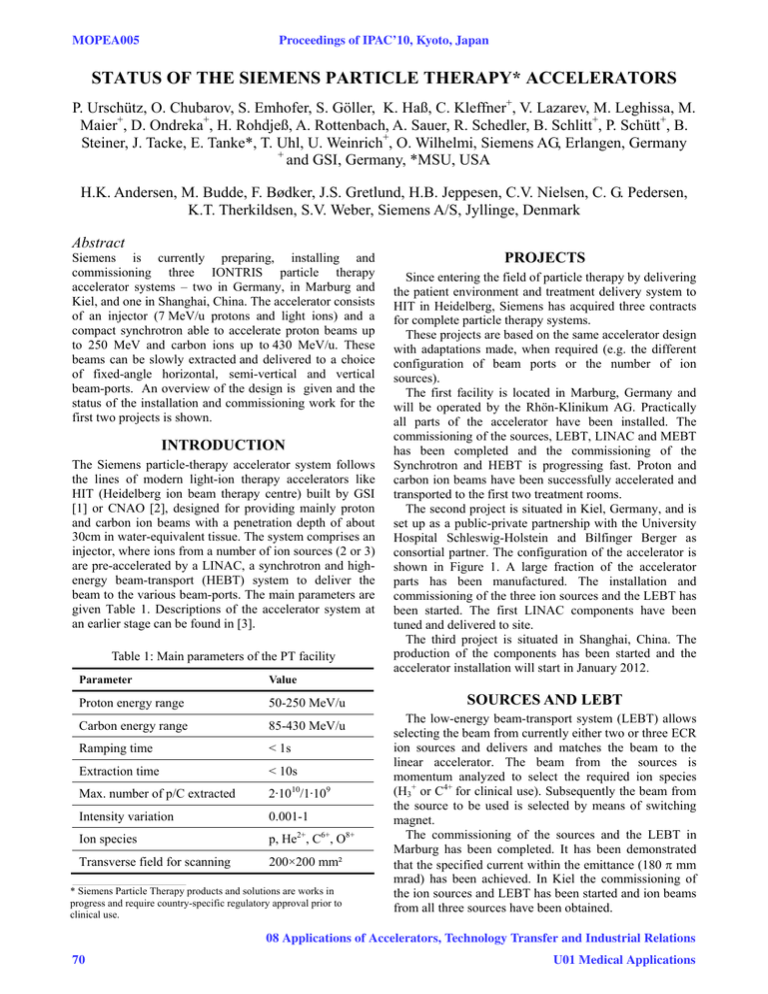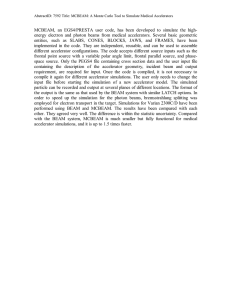Status of the SIEMENS Particle Therapy Accelerators
advertisement

MOPEA005 Proceedings of IPAC’10, Kyoto, Japan STATUS OF THE SIEMENS PARTICLE THERAPY* ACCELERATORS P. Urschütz, O. Chubarov, S. Emhofer, S. Göller, K. Haß, C. Kleffner+, V. Lazarev, M. Leghissa, M. Maier+, D. Ondreka+, H. Rohdjeß, A. Rottenbach, A. Sauer, R. Schedler, B. Schlitt+, P. Schütt+, B. Steiner, J. Tacke, E. Tanke*, T. Uhl, U. Weinrich+, O. Wilhelmi, Siemens AG, Erlangen, Germany + and GSI, Germany, *MSU, USA H.K. Andersen, M. Budde, F. Bødker, J.S. Gretlund, H.B. Jeppesen, C.V. Nielsen, C. G. Pedersen, K.T. Therkildsen, S.V. Weber, Siemens A/S, Jyllinge, Denmark Abstract Siemens is currently preparing, installing and commissioning three IONTRIS particle therapy accelerator systems – two in Germany, in Marburg and Kiel, and one in Shanghai, China. The accelerator consists of an injector (7 MeV/u protons and light ions) and a compact synchrotron able to accelerate proton beams up to 250 MeV and carbon ions up to 430 MeV/u. These beams can be slowly extracted and delivered to a choice of fixed-angle horizontal, semi-vertical and vertical beam-ports. An overview of the design is given and the status of the installation and commissioning work for the first two projects is shown. INTRODUCTION The Siemens particle-therapy accelerator system follows the lines of modern light-ion therapy accelerators like HIT (Heidelberg ion beam therapy centre) built by GSI [1] or CNAO [2], designed for providing mainly proton and carbon ion beams with a penetration depth of about 30cm in water-equivalent tissue. The system comprises an injector, where ions from a number of ion sources (2 or 3) are pre-accelerated by a LINAC, a synchrotron and highenergy beam-transport (HEBT) system to deliver the beam to the various beam-ports. The main parameters are given Table 1. Descriptions of the accelerator system at an earlier stage can be found in [3]. Table 1: Main parameters of the PT facility Parameter Value Proton energy range 50-250 MeV/u Carbon energy range 85-430 MeV/u Ramping time < 1s Extraction time < 10s Max. number of p/C extracted 2·1010/1·109 Intensity variation 0.001-1 Ion species p, He2+, C6+, O8+ Transverse field for scanning 200×200 mm² ___________________________________________ * Siemens Particle Therapy products and solutions are works in progress and require country-specific regulatory approval prior to clinical use. PROJECTS Since entering the field of particle therapy by delivering the patient environment and treatment delivery system to HIT in Heidelberg, Siemens has acquired three contracts for complete particle therapy systems. These projects are based on the same accelerator design with adaptations made, when required (e.g. the different configuration of beam ports or the number of ion sources). The first facility is located in Marburg, Germany and will be operated by the Rhön-Klinikum AG. Practically all parts of the accelerator have been installed. The commissioning of the sources, LEBT, LINAC and MEBT has been completed and the commissioning of the Synchrotron and HEBT is progressing fast. Proton and carbon ion beams have been successfully accelerated and transported to the first two treatment rooms. The second project is situated in Kiel, Germany, and is set up as a public-private partnership with the University Hospital Schleswig-Holstein and Bilfinger Berger as consortial partner. The configuration of the accelerator is shown in Figure 1. A large fraction of the accelerator parts has been manufactured. The installation and commissioning of the three ion sources and the LEBT has been started. The first LINAC components have been tuned and delivered to site. The third project is situated in Shanghai, China. The production of the components has been started and the accelerator installation will start in January 2012. SOURCES AND LEBT The low-energy beam-transport system (LEBT) allows selecting the beam from currently either two or three ECR ion sources and delivers and matches the beam to the linear accelerator. The beam from the sources is momentum analyzed to select the required ion species (H3+ or C4+ for clinical use). Subsequently the beam from the source to be used is selected by means of switching magnet. The commissioning of the sources and the LEBT in Marburg has been completed. It has been demonstrated that the specified current within the emittance (180 S mm mrad) has been achieved. In Kiel the commissioning of the ion sources and LEBT has been started and ion beams from all three sources have been obtained. 08 Applications of Accelerators, Technology Transfer and Industrial Relations 70 U01 Medical Applications Proceedings of IPAC’10, Kyoto, Japan MOPEA005 Figure 1: Layout of the particle-therapy accelerator for the Kiel project, featuring three sources and three treatment rooms with horizontal, vertical and semi-vertical (45°) beam-ports, the last two rooms contain a dual beam-port each. LINAC The linear accelerator consists of an RFQ and an IHmode drift-tube LINAC (DTL) using a design by the IAP Frankfurt for the HIT facility in Heidelberg with only minor modifications. The RFQ accelerates the particles to 400 keV/u whereas the injection energy into the synchrotron of 7 MeV/u is achieved by the DTL. After the LINAC the beam is stripped by a thin carbon foil and guided by the medium-energy beam-transport to the synchrotron. The commissioning of the LINAC and MEBT in Marburg has been completed. For the LINAC a transmission of up to 35% has been achieved, where the majority of the losses are caused by the RFQ. The Kiel RFQ has been pre-tested and adjusted at the Risø test facility in Denmark. The transmission could be raised to more than 60%. SYNCHROTRON The synchrotron is a new design (described in more detail in [3] and [4]) as compared to the HIT facility, featuring a symmetric hexagonal lattice of roughly 65 m circumference with 6 straight sections hosting the injection and extraction systems and the accelerating RF cavity (see Figure 2). For the multiturn injection scheme through a thin electrostatic septum three ferrite bumpers are located within the ring that can produce an injection bump collapsing within a few 10 μs. In this way 10 effective turns can be injected into the synchrotron, sufficient for the specified beam currents. For the acceleration on the second harmonic a ferrite loaded RF-cavity driven by a solid state amplifier has been designed and successfully tested. Extraction of the beam proceeds using a slow extraction scheme at a third order resonance, using a combination of an electrostatic and two magnetic septa. Figure 2: The Synchrotron in Marburg. The commissioning of the synchrotron is progressing fast. Recent results show that more than 10 effective turns can be injected into the synchrotron and the RF capture and acceleration efficiency is up to 90%. Protons and carbon ions have been accelerated to their maximum energies, 250 MeV and 430 MeV/u respectively. Figure 3: Chopped beam pulse in the MEBT, the accumulation of the current in the synchrotron during the multi-turn injection (MTI) and a standard synchrotron cycle for carbon ions. 08 Applications of Accelerators, Technology Transfer and Industrial Relations U01 Medical Applications 71 MOPEA005 Proceedings of IPAC’10, Kyoto, Japan Figure 3 shows the signals obtained on AC and DC current transformers in the MEBT and the synchrotron, reflecting the present commissioning status. At Kiel, the synchrotron commissioning will start in autumn 2010. HEBT The high-energy beam transport system delivers the beam from the synchrotron to the different treatment locations. The layout depends on the configuration of the required beam ports in the different treatment rooms. Figure 4 shows a part of the HEBT installation in Marburg. Figure 4: Part of the semi-vertical beam line in the HEBT in Marburg. Currently, our system feature horizontal (H), vertical (V) and semi-vertical (SV), i.e. 45° vertically inclined, beam ports. In Marburg the four treatment rooms, starting at the vicinity of the synchrotron, are equipped with the beam ports H, H, H, and SV respectively, whereas in Kiel and Shanghai the configuration is, H, H+V, and H+SV (cf. Figure 1). Here, H+V signifies that a treatment room has two beam ports pointing at the same isocenter, the nominal position of the target volume. This will provide larger flexibility in applying radiation fields from various angles during one fraction. In Siemens particle therapy systems treatment delivery uses the raster-scan method. Here the Bragg-peak is scanned over the tumour volume. Longitudinally one can only move from spill to spill by changing the extraction energy in the synchrotron, but transverse fast scanning can be achieved with fast “scanner magnets”. To have quasi-parallel scanning, these scanner magnets need to be located at least 6m away from the isocenter. Together with a focusing quadrupole doublet needed to obtain small beam diameters at the isocenter a fairly long straight beamline from the last bend to the isocenter is needed. Whereas this has not been an issue for horizontal and semi-vertical (45°) beam outlets, as used in the Marburg project, vertical beams designed along these lines would require an excessive building height. Therefore a scheme has been developed where scanning is done through the last dipole magnet, similar to gantries with parallel scanning (PSI, HIT). In this way, the vertical beam line could be designed with the same height as the semi-vertical one. In order to reduce the total weight and cost of the last 90° bend, it is realized with three 30° dipole magnets. The “vertical” scanning in the dispersive plane is done before the first magnet. The “horizontal” scanner is placed between the second and the third dipole, so that only one 30° magnet had to be designed with a large gap. This arrangement provides quasi-parallel scanning and the same variation of beam sizes as in the horizontal and semi-vertical beam-ports. In Marburg the commissioning of the HEBT has been started. Proton and carbon ion beams have been transported into the first two horizontal treatment rooms. Figure 5 shows a carbon beam in the isocenter of treatment room 2, observed with a viewing screen. Figure 5: Carbon beam in the isocenter of the second treatment room as seen by a viewing screen. CONTROL SYSTEM The control system used for the Siemens particle therapy accelerators is a variant of the one developed for the HIT facility in Heidelberg [5], however, changes induced by different beamline configuration as well as other hardware interfaces have been implemented. CONCLUSION We have given an overview of the particle therapy accelerator, designed for series production, and have given a brief account of the status of the different projects. The authors acknowledge the assistance, interest and support from staffs at GSI and HIT. We also appreciate the countless contributions from many other colleagues within Siemens and cooperating companies. REFERENCES [1] D. Ondreka and U. Weinrich, Proceedings EPAC08, p. 909 [2] M. Pullia, Proceedings EPAC08, p. 983 [3] S.P.Møller et al., Proceedings EPAC08, p. 1815 [4] S.P.Møller et al., Proceedings EPAC06, p. 2305 [5] T. Fleck et al. Proceedings ICALEPCS07, p. 48 08 Applications of Accelerators, Technology Transfer and Industrial Relations 72 U01 Medical Applications



